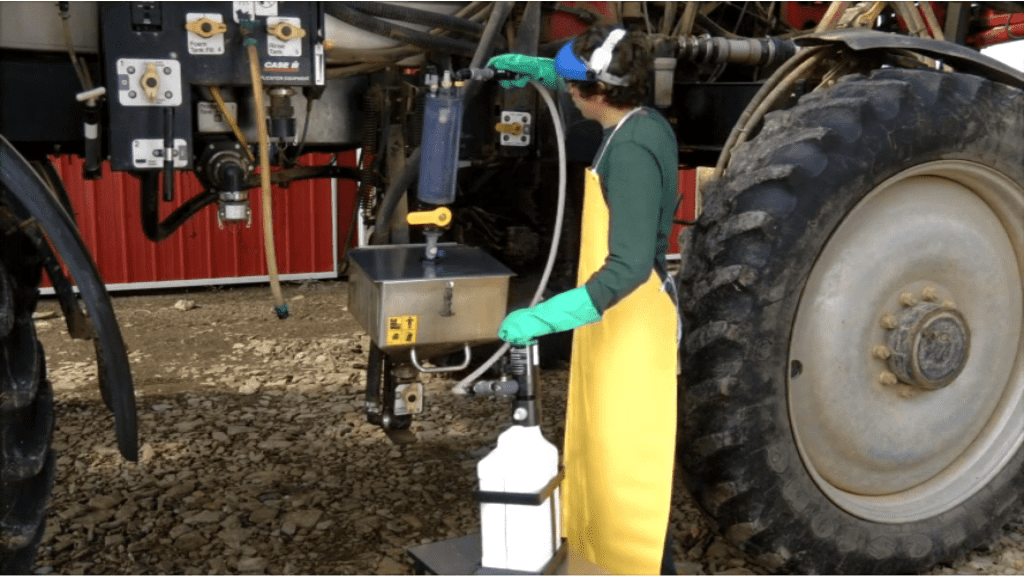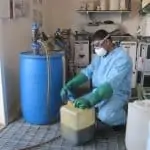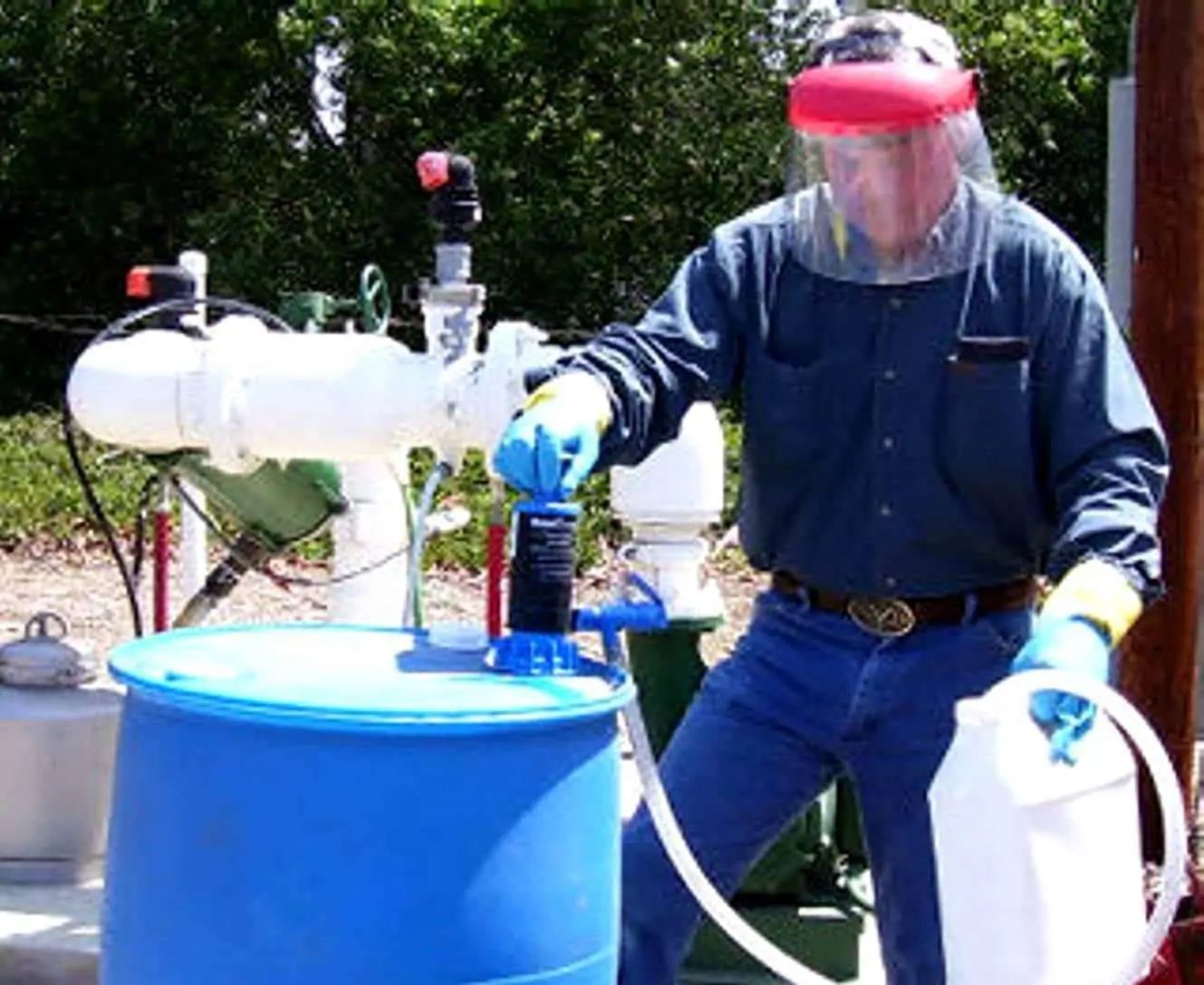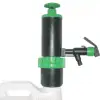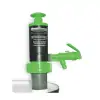GoatThroat Pumps for the Agriculture Industry
Operating efficient and successful farms requires the use of industry-grade organic and agricultural chemicals like fertilizer, herbicide, pesticide, and insecticides. These chemicals are often dangerous to handle. They are also expensive and necessary. Health detriments from improper chemical handling procedures can cause severe physical damage. With GoatThroat agriculture pumps, farmers and farmhands can safely transfer chemicals with precise control.
The enhanced safety provided by GoatThroat’s chemical-compatible seals and materials dramatically lower the risk of chemical exposure. This allows large and small farms alike to easily comply with OSHA and EPA chemical safety and environmental safety standards. GoatThroat’s insecticide pumps, herbicide pumps, pesticides pumps, and liquid fertilizer transfer pumps also provide the handler with direct control of the rate of flow. This means that farms can better manage their chemical reserves and material costs while providing a safer working environment for farmworkers, crops, and livestock.
Our pumps reduce the risk of spills, chemical exposure, and agrichemical waste. By improving the efficiency of application and reducing waste opportunities, your farm will have reduced maintenance and chemical costs.
GoatThroat pumps are also a perfect solution for facilities with limited access to power or remote storage locations. As our pumps are operated by hand, they can be applied creatively for unique situations. For example, transferring agrichemicals from storage to a mixer tank or sprayer can be performed efficiently by one worker. They also lend themselves for use in small area application processes as GoatThroat pumps can be fit for both 5-gallon and 55-gallon drums.
With our pumps, your agrichemicals will remain sealed away from possible unwanted exposure. From the time the chemicals are delivered to the farm to their application in the field, GoatThroat’s agriculture pumps help to create a closed and safe transfer process to each container along the way.
Stop Spills and Accidents When Loading + Mixing Plant Protection Products
GoatThroat Pumps are used and recommended by chemical companies including Bayer, BASF, Corteva, Pioneer, and others. Our agricultural customers rave about the reliability and ease of use of our pumps. Everyone knows that avoiding costly chemical spills saves time and money, along with keeping employees safe. GoatThroat Pumps can be used for most agricultural applications. Many users will load backpack sprayers using our spill-free technology for Restricted use chemicals that require a Closed Transfer System or even liquids such as Stump Cut with hard-to-control dyes because there are no spills, leaks, or errors.
Learn more about our Closed Transfer Systems.
Transfer Farm Chemicals Easily
GoatThroat Pumps is the go-to name when looking for an agricultural pump that can bring safety and cost savings to your farm, greenhouse, or other growing facilities. Our pumps make it possible to safely transfer a variety of liquids that range from pesticides to the oil that keeps your equipment’s engines running. Users around the country have been able to eliminate spills, reduce material waste and achieve compliance through using GoatThroat pumps as farm chemical pumps. The easy-to-use design of our pumps delivers that perfect mix of easy maintenance and use with product quality—you won’t have to worry about replacing your liquid pesticide pump for a long time.
Read any of the case studies below to learn more about how GoatThroat Pumps perform in an agricultural setting.
Choose GoatThroat Pumps when you need agriculture pumps to safely and efficiently transfer the agrichemicals your farm uses every day. You can use our pumps for transferring agrichemicals like:
- Glyphosate
- Aluminum or Zinc Phosphide
- Methyl Bromide
- Cresol
- Paraquat, Diquat
- Pyrethroids
- Formalin
- Sodium Fluoroacetate
- Organophosphates
- Neonicotinoids
- Selenium
- Livestock Vaccines
- Oil
- Equipment Lubricants
GoatThroat has perfectly fit solutions for over 2000 chemicals. With our chemical compatibility guide and extensive experience, we can provide hand drum pump solutions for your agrichemical needs. We can help you to create a sealed transfer system that makes chemical safety easy. Exposure to agrichemicals can cause immediate effects such as:
- Headache
- Poisoning
- Nausea
- Vomiting
- Pinpoint pupils
- Dizziness
- Diarrhea
- Muscle twitching
- Skin rashes
- Chemical burns
Keep your farmhands safe and the crop healthy with consistent and reliable pumps from GoatThroat. Prevent unnecessary health risks and damage to farmland with our closed and sealed agrichemical transfer pumps.
Transfer Pumps for Crop Maintenance
Crop maintenance is both an art and a science. Maintaining a balance between chemical applications, weather conditions, wildlife exposure, crop yield, and pests is a constant difficult battle. You can’t control the weather, but you can contribute to the crop yield and keep pests away.
GoatThroat transfer pumps give applicators direct control over the amount of concentrate delivered to the mix tank to achieve the correct dilute mixture. This will allow them to apply the correct solution without creating waste or over saturating the crop or surrounding soil. It’s not only a requirement for maintaining OSHA and EPA compliance but also helps to produce the best crop yields. Damaged soil from agrichemical saturation can take time and money to fix. Prevent the possibility from the start with the precise control of our insecticide, pesticide, and herbicide pumps. Keep your farmland healthy and productive.
Along with the need for accurate and controlled application, agrichemicals have to be stored in specific manners to ensure environmental safety standards. This will often mean transferring chemicals from larger tanks and drums to hand-held containers and applicators. It can also often require mixing two or more chemicals. GoatThroat pumps can give your farmhands the consistent control they need to accurately create chemical mixtures and transfer agrichemicals to and from storage containers in a closed system. Our pumps are made to prevent dangerous exposure to chemical leaks and fumes during the transfer process.
If you need transfer pump solutions or are unsure what chemical safety standards are required for your chemical reserves, you can look through our thorough chemical compatibility guide or get in contact with a professional at GoatThroat Pumps to find the solution for your needs. Our pumps are sure to increase your farm productivity while lowering maintenance costs and preventing exposure to hazardous chemicals.
Download Library.
Click on a title to download.
- AG Specific Chem Guide
- Brochure - Ag line card
- Brochure - Ag overview
- Cal DPR Product review
- Case History - Turf Magazine
- Case History - Safety with Chemicals
- Case History - Golf News
- Case History - Root Rot
- Case History - Lawn Care Company
- Closed System Line card with Overview
- Closed System Requirements from California DPR
- Cost Savings
- Minimum Exposure Rules
- Non-Ag Regs
Recommended Products
Recommended Product Categories
You might also consider the pumps and accessories found here:
Case Studies.
California DPR Review of CCS-8605 Closed Systems
SUBJECT: EVALUATION OF THE PROTOTYPE “GOAT-THROAT” CLOSED SYSTEM DEMONSTRATED IN FRESNO COUNTY ON NOVEMBER 15, 2010 FROM: Harvard R. Fong, CIH Senior Industrial Hygienist Worker Health and Safety Branch (916) 445-4211 DATE: January 6, 2011 On November 15, 2010, I traveled to the Fresno office of the Enforcement Branch’s Central Regional Office to view a demonstration of the prototype closed-system designed by GoatThroat Pumps (GTP) of Milford, CT. This demonstration was to provide verification that the closed-system component designed and manufactured by GTP complied with the closed-system requirements as stated in the Director’s Closed System Criteria (1998) document. Their particular component was the GT-300 manual pump, specially modified to meet the requirements for a closed-system device. The specific modifications related to the GT-300 included a water rinse system, a pressure relief valve and the use of dry-break couplers. Hoses for moving liquids through the GT-300 (both out of the pesticide …
Vineyards and Nurseries see big benefit to bottom line with safe chemical handling systems
The High Cost of Exposing Ag Workers to Chemicals at Point of Use The tip-and-pour method, as well as poorly designed pumps, can expose workers to injury and companies to significant financial losses Every day handlers and pesticide applicators transfer potentially hazardous chemicals and concentrates such as pesticides, herbicides, insecticides, fungicides, and liquid fertilizers from large drums into smaller containers or mixing tanks. However, this transfer process can have serious consequences if manual “tip-and-pour” techniques or poorly designed pumps are used. Whether the chemicals are toxic, corrosive, or flammable, the danger of accidental contact can pose a severe hazard to workers. Some are even categorized as “Minimal Exposure Pesticides” In fact, each year 1,800-3,000 ( this number seems low) preventable occupational incidents involving pesticide exposure are reported Keeping workers safe is not just a best management practice, it is the law. The federal Worker Protection Standard (WPS) was revised in …
Safe Chemical Handling Improves Bottom Line in Controlling Phytophthora Root Root
Rancho Rodoro, is a 40 acre avocado and lemon tree farm located in the Santa Clara River Valley of California. Owner Randall Axell divides his time between soil and pest management and improving crop production. Rancho Rodoro uses integrated practices which help to reduce Phytophthora Root Rot (PPR) spread. Until recently, Axell has been using trunk injection of phosphoric acid just prior to the initiation of new root growth in May and August which is standard application methods for phosphites. Using PhosGrowTM by International Chemical Group which is registered in California as a fertilizer he recovered 6 acres of moderately diseased trees since 2004 and has a thriving avocado grove. While this method is very appropriate for moderate to severely diseased trees, it is overkill for control and disinfection of slightly diseased areas of the orchard. Phosphite Delivery System Wanting to apply the phosphites via his existing irrigation system, Axell …
California DPR Review of CCS-8605 Closed Systems
SUBJECT: EVALUATION OF THE PROTOTYPE “GOAT-THROAT” CLOSED SYSTEM DEMONSTRATED IN FRESNO COUNTY ON NOVEMBER 15, 2010
FROM: Harvard R. Fong, CIH Senior Industrial Hygienist Worker Health and Safety Branch (916) 445-4211 DATE: January 6, 2011
On November 15, 2010, I traveled to the Fresno office of the Enforcement Branch’s Central Regional Office to view a demonstration of the prototype closed-system designed by GoatThroat Pumps (GTP) of Milford, CT. This demonstration was to provide verification that the closed-system component designed and manufactured by GTP complied with the closed-system requirements as stated in the Director’s Closed System Criteria (1998) document. Their particular component was the GT-300 manual pump, specially modified to meet the requirements for a closed-system device. The specific modifications related to the GT-300 included a water rinse system, a pressure relief valve and the use of dry-break couplers. Hoses for moving liquids through the GT-300 (both out of the pesticide container for mixing/loading and back into the container for rinsing), as well as a measuring meter, are included as parts of the closed-system loading components unique to the GTP system. The GTP would be classified as a suction-extraction device, as defined by HS Report 1849. The GTP uses a manually actuated pressurizing pump to force fluid from the container into the delivery hoses of the system. The GTP is designed to fit 63 millimeter diameter container openings (also referred to as the container “finish”) of 2.5 gallon F-style pesticide containers. Sixty three millimeter is one of the finish sizes required for non-returnable pesticide containers according to Title 40 Code of Federal Regulations Part 165.25 (d)(3). Photos One and Two shows the GTP pumping component attached to a 2.5 gallon F-style pesticide container.
The GTP system was wedded to a typical plumbing and pump assembly that provided the rinse water to the GTP and moved the liquids throughout the system. Photo Three shows the system without the GTP pumping component on the pesticide container and Photo Four shows the complete system with GTP attached. However, the gasoline-powered pump does not provide pressure for removing the pesticide from the original container; this is provided by the manual pump of the GTP. During rinsing, either the manual pump or the gasoline-powered pump can push rinsate out of the container, though to fully empty the container the manual pump must be used.
Because of the design of the plastic stinger inserted into the container to remove the pesticide, there may be potential for excessive residue left in the container. The stinger tip is cut at an oblique angle, forming a “point” with which to puncture the foil covers found on many pesticide container openings. The stinger in the exemplar GTP was cut such that a liquid layer of 1 centimeter. may be left in the bottom of the container. To reduce the potential leavings, the President of GTP stated that a less oblique angle for the stinger-end should be available for the production units. It should be noted that this condition is not necessarily unique to the GTP but can also be found in other suction-extraction systems. Care must be taken with suction-extraction devices to ensure that the extracting tube siphons as much a possible from the container, by such Mixing/loading system with GTP suction/extraction unit in place efforts as moving the extraction tube along the container floor and by tipping the container to pool residue for easier extraction. Also demonstrated by GTP, and visible in Photos Three and Four, is a container stabilized cage, to both lift the container to an appropriate working height and to prevent container tipping while the GTP pump is attached to the container. After observing the demonstration, the GTP appears to comply with the Director’s Criteria for use as a component of a closed system. Subsequent commercially available systems should be reviewed by the local County Agricultural Commissioner’s office to ensure compliance, not only for the GTP component, but also for engineering and design compliance of the remaining system parts downstream from the GTP device.
Vineyards and Nurseries see big benefit to bottom line with safe chemical handling systems
The High Cost of Exposing Ag Workers to Chemicals at Point of Use
The tip-and-pour method, as well as poorly designed pumps, can expose workers to injury and companies to significant financial losses
Every day handlers and pesticide applicators transfer potentially hazardous chemicals and concentrates such as pesticides, herbicides, insecticides, fungicides, and liquid fertilizers from large drums into smaller containers or mixing tanks. However, this transfer process can have serious consequences if manual “tip-and-pour” techniques or poorly designed pumps are used.
Whether the chemicals are toxic, corrosive, or flammable, the danger of accidental contact can pose a severe hazard to workers. Some are even categorized as “Minimal Exposure Pesticides”
In fact, each year 1,800-3,000 ( this number seems low) preventable occupational incidents involving pesticide exposure are reported Keeping workers safe is not just a best management practice, it is the law. The federal Worker Protection Standard (WPS) was revised in 2015 and now provides a greater focus on reducing pesticide exposures. A closed system of transferring chemicals reduces unnecessary exposures by providing controlled delivery of chemical products without fear of worker exposure, over-pouring, spilling, or releasing vapors. Many of the revisions became effective this January.
“Ag pesticide toxicity and corrosives are the main dangers, but even organic pesticides can be harmful if there is exposure,” says Kerry Richards, PhD, President Elect of the American Pesticide Association of Pesticide Safety Educators and former Director of Penn State’s Pesticide Safety Education Program. “Some of the non-synthetic (organic) chemicals are a particular contact risk if they are corrosive.”
In addition to the potential for injury, there can also be serious financial ramifications for the grower or ag product manufacturing facility if pesticides or liquid chemicals spill.
“Beyond workers compensation, there can be huge potential liability, EPA or state regulatory fines, as well as clean-up or remediation costs,” says Richards. “This is particularly true if a pesticide gets into a water source, kills fish, or contaminates drinking water.”
Spiraling Costs of Lost Containment
Richards, who works with the National Pesticide Safety Education Center and has over 30 years of pesticide safety education experience, says “Exposure risk is highest for those loading chemicals into mix tanks because it is more concentrated and hazardous before diluted with water. Any time you lose containment, the risks can be serious and spiral out of control.”
Corrosive chemicals, for example, can severely burn skin or eyes, and many chemical pesticides are toxic when touched or inhaled. “One synthetic herbicide is so highly acidic that it bleaches out the chloroform in plants and kills them,” says Richards. “If you splash it in your eye, you will burn out your cornea.”
Some chemicals are flammable as well, and if not properly handled and contained, can be ignited by sparking from nearby motors or mechanical equipment. The danger of a fire spreading can be serious both in the field and at ag product manufacturing facilities.
In addition to the cost of cleanup or treating injuries, substantial indirect costs can also be incurred. These include supervisors’ time to document the incident and respond to any added government inspection or scrutiny, as well as the potential for slowed grower production or even a temporary shutdown at ag manufacturing plants.
“The direct and indirect costs of a pesticide spill or injury can be substantial, not the least of which is the loss of wasted chemicals,” says Richards. “Pesticides, particularly newer concentrated formulations, are very expensive so spilling a few ounces could cost you several hundred dollars in lost product during a single transfer.”
Chemical Transfer Techniques
Traditional practices of transferring liquid chemicals suffer from a number of drawbacks. Manual techniques, such as the tip-and-pour method, are still common today. Tipping heavy barrels or even 2.5 G containers, however, can lead to a loss of control and over pouring.
“Some growers choose to transfer chemicals manually, but it is very difficult to control heavy drums,” cautions Richards. “I’d advise against it because the risk of a spill is so high, and it can lead to back injury or muscle strain as well.”
Although a number of pump types exist for chemical transfer (rotary, siphon, lever-action, piston and electric), most are not engineered as a sealed, contained system. In addition, these pumps can have seals that leak, are known to wear out quickly, and can be difficult to operate, making precise volume control and dispensing difficult.
In contrast, closed systems can dramatically improve the safety and efficiency of chemical transfer. California’s Department of Pesticide Regulation, in fact, requires a closed system for mixing and so handlers are not directly exposed to the pesticide.
“Either A closed, or a sealed system is ideal for handling pesticides or other dangerous chemicals, and is becoming a best practice technique,” says Richards. “With such devices, like GoatThroat Pumps, you can maintain a controlled containment from one vessel to another that limits any potential exposure.”
A sealed system delivers liquids to an intermediate measuring device and is useful for low toxicity liquids. A closed system moves the material from point A to Point B without leaking or causing exposure to the handler through hoses using dry-break fittings on the connection points means no applicator exposure and helps guarantee safety. Liquids are transferred from the source container, into the measuring system, and then to the mix tank.
Small, versatile, hand-operated pressure pumps, such as those manufactured by GoatThroat Pumps, are engineered to work as a system which can be either closed or sealed. The pumps can be used for the safe transfer of over 1400 industrial chemicals, including the most aggressive pesticides.
These pumps function essentially like a beer tap. The operator attaches the pump, presses the plunger several times to build up a low amount of internal pressure, and then dispenses the liquid. The device is configured to provide precise control over the fluid delivery, from slow (1ML/ 1 oz.) up to 4.5 gallons per minute, depending on viscosity.
Because such pumps use very low pressure (<6 PSI) to transfer fluids through the line and contain automatic pressure relief valves, they are safe to use with virtually any container from 2-gallon jugs to 55-gallon drums.
Ricci Vineyards Adopts “Best Practice” Pump Systems
When Jon DiPiero managed Ricci Vineyards, a small wine grape vineyard in Sonoma, CA, he sought a safer, more efficient way to transfer pesticides for mixing and spraying that complied with the state’s closed system requirement for MEPs. Once again this word
“We had to fill 2.5 gallon containers from a 55 gallon drum,” says DiPiero. “Traditional tipping and pouring from a drum wasn’t going to work due to the potential for spills, splashes, over pouring and chemical exposure, as well as the state mandate for a closed system for some pesticides.”
DiPiero turned to GoatThroat Pumps and was happy with the results for a number of reasons.
“Because the pump is closed, sealed, and allows containers to remain in an upright position, it complied with state regulation and virtually eliminated the potential for all forms of chemical exposure,” says DiPiero.
Piero says the air pressure supplied by the hand pump allows the precise flow required into a measuring cylinder.
In case of overfill, Piero says, “The operator can open a valve to release air pressure and the pesticide will backflow into the tank with no cross contamination. This gave us the exact amount we needed so there was no waste.”
According to DiPiero, a multi directional spray attachment also enables rinsing of every corner of container without having to pour into it and shake it. He says this helps to minimize exposure when cleaning a container for reuse and satisfies California “triple rinsing” requirements.
“Whether for pesticides, herbicides, fungicides, or liquid fertilizers, a closed and sealed pump design could help with the safe production or mixing of any liquid chemical,” says DiPiero.
Safe Chemical Handling at Lancaster Farms
When Lancaster Farms, a wholesale container plant nursery serving the Mid-Atlantic and New England regions, required a higher chemical pH to adjust its well water for a pesticide spray application, it had to transfer acid to buffer the spray water.
According to Shawn Jones, Lancaster Farms’ Propagation and Research Manager, for bulk cost savings, the nursery chose to purchase 55 gallon drums of sulfuric acid to raise chemical pH. However, Jones was wary of the danger that tipping and pouring acid from the drums would pose, along with pouring bleach and another strong disinfectant for a different use in the propagation area.
“We use 40% sulfuric acid to buffer our spray water,” says Jones. “Our water is recycled, with some storage areas relatively close to our water source, so wanted to avoid any possibility of accidental spillage.”
Previously, the nursery had used siphon pumps to transfer the acid, bleach, and disinfectant, but Jones was dissatisfied with this approach. “None of our siphon pumps lasted more than six months before we had to replace them, and none allowed metering with the kind of precision we required,” he says.
Instead, Jones chose to implement several closed, sealed GoatThroat Pumps, along with graduated cylinder attachments for precise measurement. “With the pumps, the drums always remain in an upright position so they won’t tip over accidentally,” says Jones. “We get precise measurement into our mix tanks. We use every drop, spill nothing, and waste nothing.”
In terms of longevity, Jones’ first closed, sealed pump has already lasted six years and outlasted a dozen previous siphon pumps.
“Our GoatThroat Pumps paid for themselves in safety and savings our first growing season, and should last a decade or more with just routine maintenance or repair,” concludes Jones. “Any grower, farmer, or nursery that needs to move or measure dangerous liquids safely and reliably should consider one.”
Agricultural chemicals are very expensive, and growers are always looking for ways to decrease the cost of inputs to help increase profits. Sealed systems and closed systems allow for accurate and precise measuring of chemicals, which ensures that you’re using only the amount of product required and not one extra drop. Taking the guesswork out of measuring costly materials, and providing an efficient means of transferring custom blended or dilute products from original containers to mix tanks or back pack sprayers cuts input costs. This keeps expenses to a minimum, with the important bonus of increasing the safety of handlers by reducing the potential exposure to the chemical, which helps increase the bottom line and can assist with Worker Protection Standard regulatory compliance.
For more info: call 866-639-4628 toll free; Fax: 212-243-6070; E-mail info@goatthroat.com; or write to Westcott Distribution, Inc. 60 Shell Avenue Milford, CT 06460.
Safe Chemical Handling Improves Bottom Line in Controlling Phytophthora Root Root
Rancho Rodoro, is a 40 acre avocado and lemon tree farm located in the Santa Clara River Valley of California. Owner Randall Axell divides his time between soil and pest management and improving crop production. Rancho Rodoro uses integrated practices which help to reduce Phytophthora Root Rot (PPR) spread.
Until recently, Axell has been using trunk injection of phosphoric acid just prior to the initiation of new root growth in May and August which is standard application methods for phosphites. Using PhosGrowTM by International Chemical Group which is registered in California as a fertilizer he recovered 6 acres of moderately diseased trees since 2004 and has a thriving avocado grove. While this method is very appropriate for moderate to severely diseased trees, it is overkill for control and disinfection of slightly diseased areas of the orchard.
Phosphite Delivery System
Wanting to apply the phosphites via his existing irrigation system, Axell had trouble finding a transfer pump which would hold up to the acid and provide a safe solution for eliminate leaks and spills when moving the acid to the fertilizer tanks. He tried several pumps, none of which worked out. Finally he found GoatThroat Pumps.
“The GoatThroat pumps have adapters to fit all of my different containers,” states Axell.
“We simply open up the tap and dispense a cup, a quart or a gallon depending on our need. This tool has improved the safety of our workers and helped us to be more compliant with local regulations. Because we have control of the amount of acid which is dispensed at one time, we are able to meet our HACCP requirements more easily. And our crop production is up 10 – 20% since 2004.”
